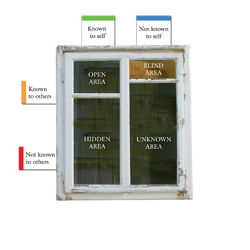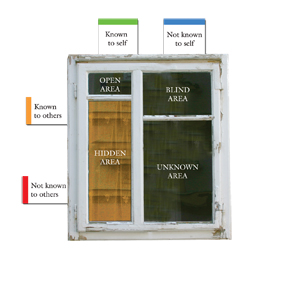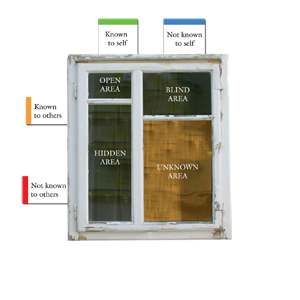
Features
Leadership
Window of opportunity: Johari leadership system builds trust, fosters teamwork
Building trust in the fire department can be challenging for any fire-service leader; however challenging it may be, leaders working in high-performance fire departments must understand interpersonal relations and the steps required to foster trust in the team.
December 12, 2007
By Les Karpluk

Building trust in the fire department can be challenging for any fire-service leader; however challenging it may be, leaders working in high-performance fire departments must understand interpersonal relations and the steps required to foster trust in the team. Building an environment of trust in the department is beyond the scope of one individual, and, like most qualities, requires leadership from the chief and every officer in the department. When trust exists in the department, morale, motivation and employee retention is high. Take note: every officer in the department must contribute to the “trust” environment.
Noted fire-service author Chase Sargent states in From Buddy to Boss, “It’s a game of relationships and trust – nothing more, nothing less.”
Trust and self disclosure
Webster’s online dictionary identifies trust as “believing in the honesty and reliability of others.” Without a strong sense of trust (believing in others) department members will not feel appreciated, nor will they take those extra steps in the delivery of our services to the public. When an environment of trust exists in the department the team gels and the department is able to flex in the midst of internal and external pressures. And we all know that these internal and external pressures can change the course of the department over time.
Psychologists have been interested in how people connect and how they reveal information to each other. Self disclosure is how we reveal more of ourselves to others so we can connect and build a relationship. Self disclosure should not be viewed as simply sharing intimate information with others; rather it is about sharing our interests, favourite movies or other information that would not be normally revealed. This can be complex and information should be shared in the right way at the right time. When properly applied, self disclosure can build a solid foundation of trust among team members.
The Johari Window
The Johari Window is a leadership tool that helps to build trust and create a new level of teamwork in the department. Developed in 1955 by psychologists Joseph Luft and Harry Ingham, (hence the name Johari) The Johari Window is a model used to improve understanding, communication and interpersonal relations. This is an excellent model that officers can use with firefighters to:
- Build and foster trust among individuals by disclosing information about themselves;
- Learn about themselves and deal with
- personal issues
- Before panicking about disclosure and receiving feedback from firefighters, a basic understanding of The Johari Window is necessary. The Johari Window is based on four aspects of our personalities:
- Areas we are open about;
- Aspects that we keep to ourselves;
- Aspects of our personalities that others see in us;
- Areas we are not aware of.
 Let’s examine each pane in The Johari Window and learn how fire officers can use this model to develop trust among firefighters. Each pane in the window contains
Let’s examine each pane in The Johari Window and learn how fire officers can use this model to develop trust among firefighters. Each pane in the window contains
information that is known or unknown by the person (fire officer), and whether this
information is known or unknown by others in the team (firefighters).
Pane 1 (Open): The attitudes, feelings, behaviours, experiences, knowledge and skills known by the person (fire officer) and known by the team (firefighters). This can be considered the most productive pane as the team is able to communicate and co-operate without mistrust or misunderstanding. The aim of the team is to develop this area and become effective in department goals and objectives.
A new fire officer (person) on shift starts with small Open and Blind areas because the team (firefighters) knows little about the officer. The Hidden and Unknown areas are larger because the person is lacking in self-knowledge or belief.
The fire officer can expand vertically into the Blind area by seeking and listening to feedback from others in the team. The Hidden area can be expanded horizontally downwards by disclosing information, feelings, and expectations to the team.
 The fire officer on shift has the responsibility to create a large Open area by promoting honest, open and constructive sharing of knowledge among members of the team. In researching top-performing organizations it becomes clear that the Open area is a primary leadership tool.
The fire officer on shift has the responsibility to create a large Open area by promoting honest, open and constructive sharing of knowledge among members of the team. In researching top-performing organizations it becomes clear that the Open area is a primary leadership tool.
Pane 2 (Blind): What is known by the team (firefighters) and unknown by the person (fire officer). If a fire officer (person) has not fostered open communication in the past, the team (firefighters) may think its officer is deliberately withholding information and, consequently, credibility issues arise.
The aim of the fire officer is to reduce the Blind area by seeking feedback from others, therefore increasing the Open area. Some members of the team may fear being open and honest with the fire officer and it is vital that the fire officer promote open and honest feedback. This takes time and the proactive fire officer will seek feedback from team members in order to build up the team.
Pane 3 (Hidden): What is known by the person (fire officer) but kept hidden or unknown to others (firefighters). In this pane the fire officer may fear vulnerability if he reveals some feelings, fears or attitudes. A large Hidden area may influence others to keep their feelings, fears or attitudes to themselves.
 Reducing the Hidden area will take time, as disclosing personal feelings and information is best left to personal discretion. Again, the goal of the fire officer is to foster the environment of trust and expand the Hidden area horizontally into the Open area.
Reducing the Hidden area will take time, as disclosing personal feelings and information is best left to personal discretion. Again, the goal of the fire officer is to foster the environment of trust and expand the Hidden area horizontally into the Open area.
Pane 4 (Unknown): What is unknown by the person (fire officer) and also unknown by the team (firefighters).
The fire officer (person) may be unaware of the team’s (firefighters’) feelings on a topic; similarly, the team is unaware of the fire officer’s feeling on the same topic. For example, the team may want to expand its confined-space training while the fire officer feels that confined-space rescue is a service best left for an outside agency. This Unknown area becomes a barrier to effective team building. Through a disclosure process, the team may discover that the fire officer had a negative experience early in his/her career and is not confident with confined-space training. By uncovering hidden talents the fire officer may find that a member of the team is very knowledgeable in confined-space training and can work with the fire officer in the delivery of confined-space training.
The Hidden area can be reduced through shared discovery, self discovery and the observations of others. The goal of leaders is to encourage the development of the Open area for everyone.
 Trust is built over time and through small steps. The glue that holds a team together is the trust in each other, and the team’s values and beliefs. Members in the department need to know and trust that chief officers will be truthful, even it means bad news.
Trust is built over time and through small steps. The glue that holds a team together is the trust in each other, and the team’s values and beliefs. Members in the department need to know and trust that chief officers will be truthful, even it means bad news.
Using the self-disclosure process, it takes hard work and time to change behaviours and foster an environment of trust in a department. A progressive officer using The Johari Window recognizes that self disclosure is achieved one step at a time through progressive disclosure. Over time, both the fire officer (person) and team (firefighters) are able to exchange personal and emotional information with each other, resulting in a trusting relationship.
Les Karpluk, CFO, BAppBUS: ES is chief of Prince Albert Fire and Emergency Services. He is a graduate of the Certificate in Fire Service Leadership and Fire Service Administration programs at Dalhousie University and graduate of the Bachelor of Applied Business: Emergency.
Sources: Adler, R., et al (2001). Interplay: The Process of Interpersonal Communication. Oxford University Press; Sargent, C., (2006). From Buddy to Boss: Effective Fire Service Leadership. Penwell Corporation.
Print this page